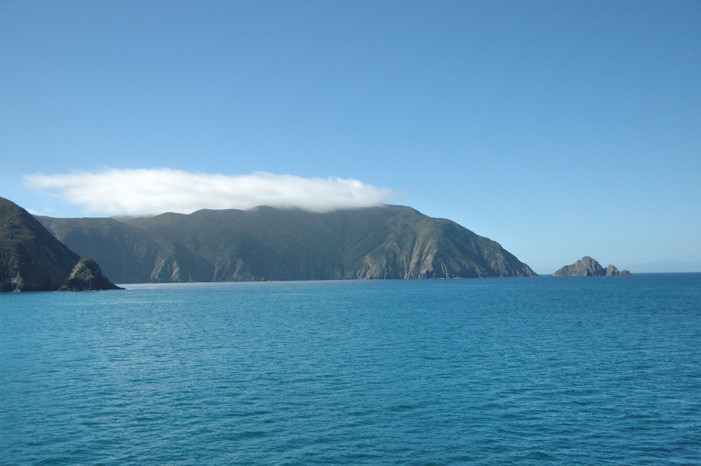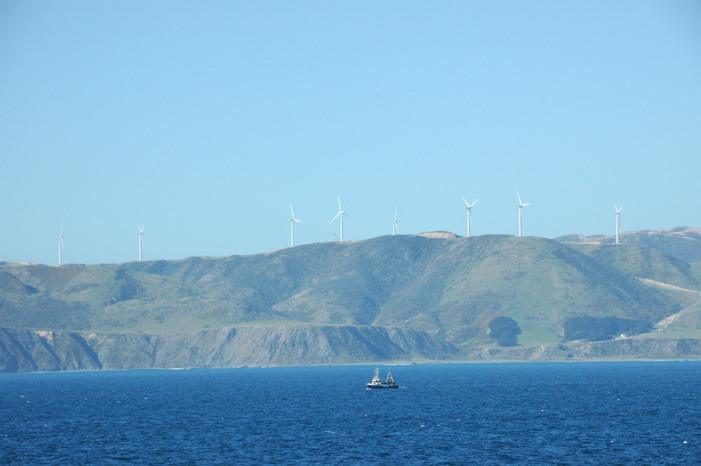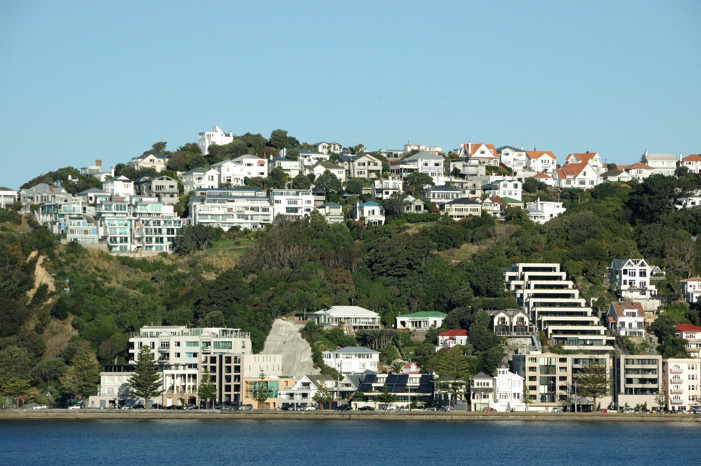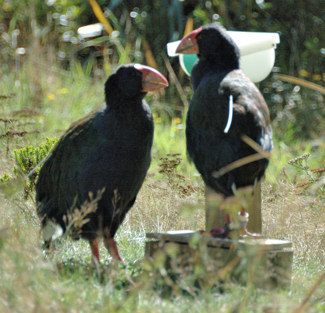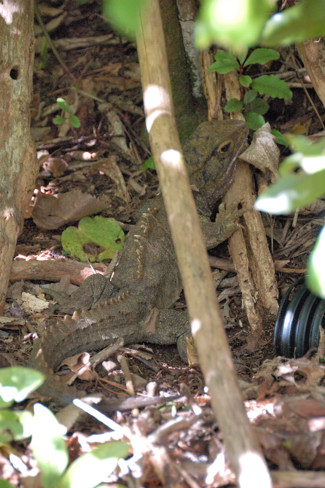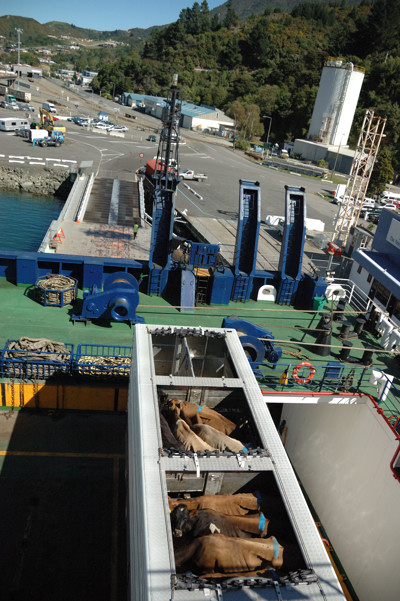 On our final day on the South Island we drove to the picturesque port city of Picton to turn in our rental car and catch the ferry to Wellington. Although we allowed what seemed like ample time for that process, Ted almost missed the boat. It turns out that there are two ferry services that make this run and, although their docks are next to each other as the crow flies, because of the way the port is organized, they are about 2 miles from each other by road. We figured that out, got to the proper terminal, and dropped off our (too) many bags, only to discover that the only place to drop off the car was at the other ferry terminal. After much racing around, Ted did succeed in turning in the car and getting back to the ferry office in time to be the last on the bus that carries walk-ons onto the ferry. This was a huge ferry, with two decks holding cars and tractor-trailer trucks carrying shipping containers, logs, and the unhappy cattle that you can see in the picture on the right. The picture below seems fitting as a last image of the wonderful South Island.
On our final day on the South Island we drove to the picturesque port city of Picton to turn in our rental car and catch the ferry to Wellington. Although we allowed what seemed like ample time for that process, Ted almost missed the boat. It turns out that there are two ferry services that make this run and, although their docks are next to each other as the crow flies, because of the way the port is organized, they are about 2 miles from each other by road. We figured that out, got to the proper terminal, and dropped off our (too) many bags, only to discover that the only place to drop off the car was at the other ferry terminal. After much racing around, Ted did succeed in turning in the car and getting back to the ferry office in time to be the last on the bus that carries walk-ons onto the ferry. This was a huge ferry, with two decks holding cars and tractor-trailer trucks carrying shipping containers, logs, and the unhappy cattle that you can see in the picture on the right. The picture below seems fitting as a last image of the wonderful South Island.
Our first image of the north island was the wind-turbine dotted ridge shown below.
After a 4 hour cruise, the ferry arrived about 40 minutes late into Wellington, where it docked at the heart of downtown, across from the railway station to which we would return in 37 hours. Wellington, like so many of the coastal cities in New Zealand, has a location that was undoubtedly chosen for its protected harbor and not the ease of building a city given the steep terrain. The photo below shows the Roseneath section of Wellington.
We were met at the ferry by Jackie Sommerville. She and her husband William had become quite friendly in Ecuador, with the Hardestys, who were good friends of ours in Chatham who had two daughters about the same age as Taylor and Haywood. When she heard that we would be in Wellington, Kathy Hardesty suggested that we would enjoy meeting the Sommervilles and helped us get in email contact. We suggested meeting for dinner; however, in what seems to be typical New Zealand style, they countered that we should stay with them for our two nights in Wellington. Not only did the put us up and help us get around the city, but that night, they fed us a sumptuous lamb dinner joined by the daughter Suzanna and her partner Simon. (We did manage to take them out to dinner our second night. We went to the restaurant in the Intercontinental Hotel where we had a wonderful meal.) Suzanna and Simon are both a year or two older than Taylor and about to embark on OE – Overseas Experience – year, which seems to be something that most educated young adults from New Zealand do. They will be leaving established jobs to travel (at various times with each set of parents) in Asia for a month before going to London for at least a year. Because they are from a Commonwealth country, they can get reasonable visas that will let them work in the UK, where they hope to be able to find good jobs that will further their careers and also allow them to visit Europe. This was all quite interesting to learn about given the things that our girls are pondering for the next year.
Jackie and William are the principles in an export firm, Asil Group Limited. Their firm exports products that come from the sea in the Pacific Islands, mainly bêche-de-mer, trochus shell, mother of pearl shells, green snail shell, giant clam shells and seaweed. They are also the sole exporter of Whittaker’s chocolate and handle other food exports, mainly to Asia. They are lovely, interesting people, and we certainly enjoyed meeting them and hope to see them again someday.
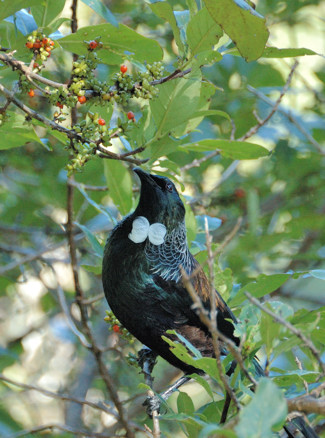 We had many plans for our one full day in Wellington. However, we decided to go to Zealandia first and enjoyed it so much that we ended up spending the entire day there. Zealandia is a hilly area roughly a mile square just ten minutes from the center of Wellington that is being turned into a preserve for many of the endemic New Zealand species that have almost become extinct since the introduction of mammals – primarily rodents, possums, and stoats, but also cats and dogs. For the most part these plants and animals have only been able to survive on small, offshore islands that, because of their size and location, did not have these mammals introduced. Zealandia is unique, however, because of its location on one of the main islands within a major city. To create Zealandia, it was necessary to create something of an ecological island (or living ark as they call it) by erecting a fence around the entire area able to exclude the predator mammals. This proved no small task as the animals are adept at climbing, jumping, burrowing, etc. Having built the fence – that seems to be working – it was necessary to eradicate all of the predator mammals within the area, a process that took several years. Since then, for the last 30 years, they have been slowly eliminating non-native plants and introducing the endangered animals: e.g., kiwi, tuatara (a slow living, lizard like animal that split from the rest of the animal kingdom before the dinosaurs; pictured below on the right), frogs, tui (pictured on the right), takahe (pictured below on the left). One of the measures of the success of this enterprise is that not only have these species flourished within the reserve, but their populations have been spreading outside as well.
We had many plans for our one full day in Wellington. However, we decided to go to Zealandia first and enjoyed it so much that we ended up spending the entire day there. Zealandia is a hilly area roughly a mile square just ten minutes from the center of Wellington that is being turned into a preserve for many of the endemic New Zealand species that have almost become extinct since the introduction of mammals – primarily rodents, possums, and stoats, but also cats and dogs. For the most part these plants and animals have only been able to survive on small, offshore islands that, because of their size and location, did not have these mammals introduced. Zealandia is unique, however, because of its location on one of the main islands within a major city. To create Zealandia, it was necessary to create something of an ecological island (or living ark as they call it) by erecting a fence around the entire area able to exclude the predator mammals. This proved no small task as the animals are adept at climbing, jumping, burrowing, etc. Having built the fence – that seems to be working – it was necessary to eradicate all of the predator mammals within the area, a process that took several years. Since then, for the last 30 years, they have been slowly eliminating non-native plants and introducing the endangered animals: e.g., kiwi, tuatara (a slow living, lizard like animal that split from the rest of the animal kingdom before the dinosaurs; pictured below on the right), frogs, tui (pictured on the right), takahe (pictured below on the left). One of the measures of the success of this enterprise is that not only have these species flourished within the reserve, but their populations have been spreading outside as well.
The next day we boarded the Tranz Scenic Overlander train for the 12 hour ride from Wellington to Auckland. Although this was a much better way to see a lot of the North Island than the equivalent drive would have been, it was not the truly spectacular train trip that some of us had hoped for.
